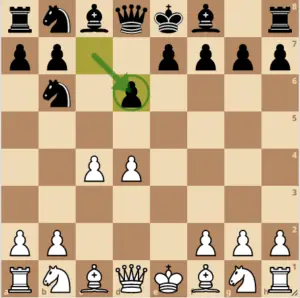Learning how pawns capture can be a lot to take in for those who are just getting started with chess. But it is really not complicated. This article will simplify things for you.
One common question I hear from beginners is “Can a pawn capture on its first move”. Well, if you’ve been studying the game of chess, you should know that pawns move forward one square or 2 squares forward on their first move.
However, they capture one square diagonally forward. So does this mean that a pawn can capture on its first move? Here is what you should know:
Can A Pawn Capture On Its First Move?
The pawn can capture diagonally forward on its first move from its starting position. If an enemy piece gets close enough such that it is one square left or right in front of the pawn, then that piece can be captured, even if the pawn is in its initial position.
At the start of a chess game, the pawns are on the 2nd and 7th rank of the chess board. As they move forward, lines begin to open up for your pieces and tension begins to build on the chessboard as they come in contact with other pieces.
This tension can lead to exchanges/capture in the center of the board. It’s usually in the center of the board that pawns capture, but captures can also take place on the 2nd and 7 th rank of the chessboard. So yes, pawns can capture on their first move. Let’s look at some real examples from some of the most popular played chess openings.
Here are 5 chess openings where a pawn captured a piece on its first move:
1. Ruy Lopez Exchange Variation: (1.e4 e5 2.Nf3 Nc6 3.Bb5 a6 4.Bxc6 dxc6)
2. Nimzo-Indian Defence Sämisch Variation: (1.d4 Nf6 2.c4 e6 3.Nc3 Bb4 4.a3 Bxc3+ 5.bxc3)
3. Alekhine Defense Exchange Variation: (1.e4 Nf6 2.e5 Nd5 3.d4 d6 4.c4 Nb6 5.exd6 cxd6)
4. Scotch Game Classical Variation: (1.e4 e5 2.Nf3 Nc6 3.d4 exd4 4.Nxd4 Bc5 5.Nxc6 Qf6 6.Qd2 dxc6)
5. Accelerated Dragon, Modern Bc4 Variation: (1.e4 c5 2.Nf3 Nc6 3.d4 cxd4 4.Nxd4 g6 5.Nc3 Bg7 6.Be3 Nf6 7.Bc4 O-O 8.Bb3 d6 9.f3 Na5 10.Qd2 Nxb3 11.axb3)
1. Ruy Lopez (Exchange Variation)
(1.e4 e5 2.Nf3 Nc6 3.Bb5 a6 4.Bxc6 dxc6 )
Black’s d-pawn capture the bishop on c6 on its first move

This is called the Ruy Lopez exchange variation and is the second most popular line in the Morphy’s Defense. Black pushes the a-pawn one square forward to question the placement of white’s bishop on b5. Black has two choices, maintain the tension with 4.Ba4 or capture the knight via 4.Bxc6.
In this example, white captures the knight on c6, thereby messing up Black’s pawn structure to some extent and threatening to capture the pawn on e5 (but not straight away though, as white can run into Qd4).
Black typically recaptures with the d pawn to open up lines for his light squared bishop on c8.
As you can see, the black pawn on d7 captured the bishop on c6. This goes to show that pawns can indeed capture on their first move.
Black could have also recaptured the bishop using his b7 pawn. However, this move is not favorable for Black because that would damage his pawns structure, leaving an isolated a-pawn on the flank.
Click the arrows to swift through the game
Let’s look at some more examples.
2. Nimzo-Indian Defence (Sämisch Variation)
(1.d4 Nf6 2.c4 e6 3.Nc3 Bb4 4.a3 Bxc3+ 5.bxc3)
White’s pawn on b2 captured the bishop on its first move

Another popular opening choice for white. If you are a Queen’s pawn player, you definitely come across this opening a few times in your career. Similarly to our previous example, Black wants to relinquish white’s control over the center by exchanging off the knight on c3.
White plays 4.a3 and ask the bishop what are you doing? Black captures the knight on c3 and was able to mess up white’s pawn structure after 5.bxc3.
Notice the pawn on b2 captured the bishop on c3. The pawn on b2 was in its initial position and moved one square diagonally on the his first move to recapture the bishop. This is another example that pawns can indeed capture on their first move.
3. Alekhine Defense (Exchange Variation)
(1.e4 Nf6 2.e5 Nd5 3.d4 d6 4.c4 Nb6 5.exd6 cxd6)
Black’s c7 pawn captured on its first move

The Alekhine Defense is a hypermodern way of playing chess, though it has been around for a very long time. Black allows white to push his pawns in the center and attack the knight.
However, Black’s strategy is to slowly develop his pieces in a hypermodern fashion and to execute a timely counter in the center. Black usually does this by fianchettoeing his bishop on g7, and breaks with e5 or d5 in certain lines.
In the exhange variation of the Alekhine Defense, Black has to common ways of recapturing:
- 5…cxd6 or
- 5…exd6
Both captures are good and have their own merits. These pawns capture on their first move.
Capturing with the c pawn leaves the option open to strike with e5 in the center. Black would have a pawn majority in the center which he can use at his advantage. In this position, black usually fianchettoes the dark squared bishop to g7 and does a timely e5 break.
Capturing with the e pawn leads to a different pawn structure and gameplay. This opens up the e-file and can lead to a potential c-5 break in the center.
All in all both moves are equally strong, with each having their own strategic idea.
4. Scotch Game (Classical Variation)
1.e4 e5 2.Nf3 Nc6 3.d4 exd4 4.Nxd4 Bc5 5.Nxc6 Qf6 6.Qd2 dxc6

Black’s d-pawn captured the knight on its first move in the classical variation of the Scotch Game. In this variation, White releases the tension in the center by playing 5.Nxc6 as Black was threatening to win the knight since it had two pieces attacking it.
The most common reply after 5.Nxc6 is 5…Qf6.
Black doesn’t rush to recapture. Instead he brings out his Queen to f6 which threatens mate in 1.
White must defend this threat. He can play any of the following Queen moves: Qd2, Qe2, or even Qf3
Afterwhich, black follows up by recapturing the knight with his d7 pawn. Black could have also recaptured with his b7 pawn, but dxc6 is arguably slightly better as it opens up lines for the light squared bishop on c8.
dxc6 also preserves black’s pawn structure and keep it intact.
5. Sicilian Defense (Accelerated Dragon, Modern Bc4 Variation)
1.e4 c5 2.Nf3 Nc6 3.d4 cxd4 4.Nxd4 g6 5.Nc3 Bg7 6.Be3 Nf6 7.Bc4 O-O 8.Bb3 d6 9.f3 Na5 10.Qd2 Nxb3 11.axb3
White’s a-pawn captured on its first move

In this position, white captured back the knight on b3 and in doing so opened up the a-file for his rook. This type of capture is common over the board as it helps to activate the rook and keep the position flexible.
This opening is known as the Accelerated Dragon, Modern Bc4 Variation of the Sicilian Defense. White deploys his bishop on c4 in order to maintain control over the center as Black usually breaks in the center with d5.
The Bishop on c4 is also a very active piece and can be dangerous in attacks against the king. This is why Black plays Na5 to exchange off the active bishop. You can view the full game below.
Final Verdict
Pawns are the soul of chess. Without them there wouldn’t be a chess game. It’s important to learn how pawns capture in chess if you are to become a better chess player.
This article helped you understand that pawns can indeed capture on their first move from their starting position. In fact, there are dozens if not hundreds of more examples where a pawn captured on its first move.
But we can’t cover all of them in one article. Nevertheless, I hoped you learned something from this article. Have fun playing your games!


